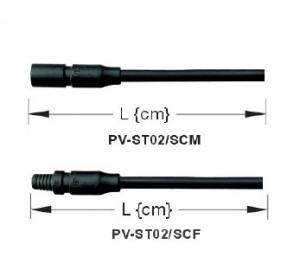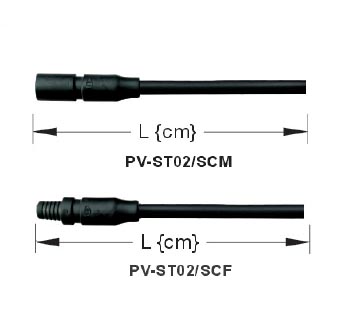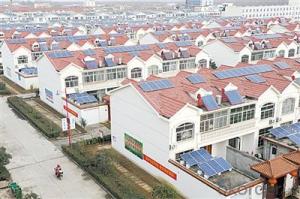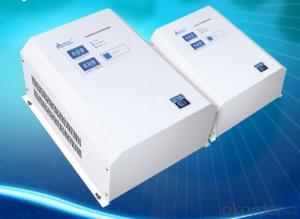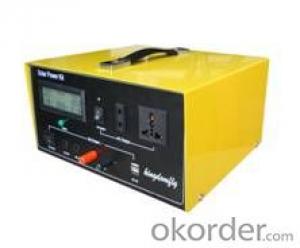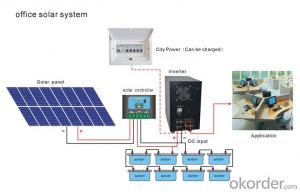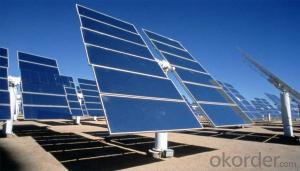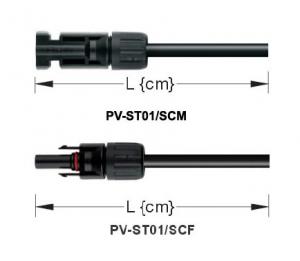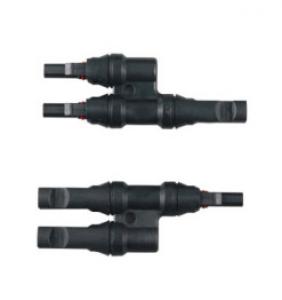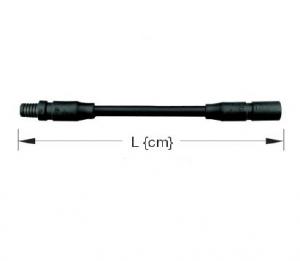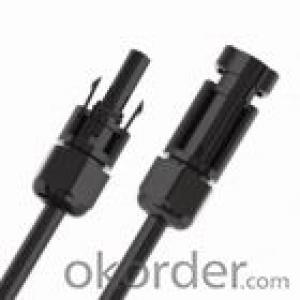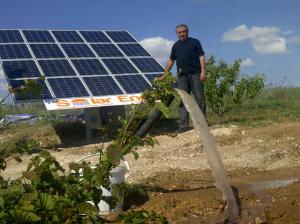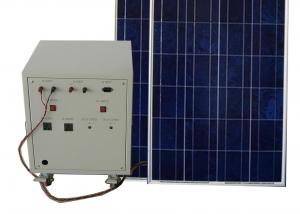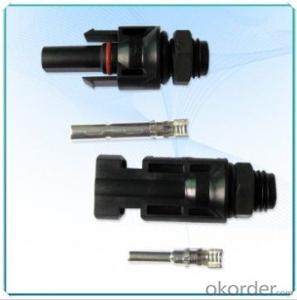Ses Solar Energy Systems PV-ST02 SCM SCF Solar Cable Connector
- Loading Port:
- China Main Port
- Payment Terms:
- TT OR LC
- Min Order Qty:
- -
- Supply Capability:
- 10000 set/month
OKorder Service Pledge
OKorder Financial Service
You Might Also Like
Solar Cable-Connectors,Due to highly robustness,UV-resistance,the touch protection a high grade connection is guaranteed for many years
Rated voltage 1000 V
Rated current 20A
Dia.of pin or socket 3mm
Protection degree(mated,junction box closed/unmated) IP67/IP2X
Operating temperature -40 °c to +85 °c
Contact material Copper,silver plated
Cable cross on request: 2.5mm2 4mm2
- Q: How do solar energy systems contribute to reducing carbon emissions?
- Solar energy systems play a crucial role in the reduction of carbon emissions through various means. Firstly, solar energy, being a renewable and eco-friendly power source, helps tackle this issue. By utilizing solar panels that convert sunlight into electricity without emitting any greenhouse gases, solar energy eliminates the release of carbon dioxide and other harmful pollutants into the atmosphere, a stark contrast to traditional fossil fuel power plants. Secondly, solar energy has the potential to replace the usage of fossil fuels in multiple sectors. For instance, residential rooftops can be fitted with solar panels to generate electricity for homes, reducing the dependence on coal or natural gas for power generation. Similarly, solar farms can be established to produce large-scale solar power for commercial and industrial purposes. By substituting fossil fuels, solar energy systems contribute to the reduction of carbon emissions associated with electricity generation. Furthermore, solar energy can also be utilized for heating purposes. Solar thermal systems can capture the sun's heat and provide hot water for residential and commercial buildings. By incorporating solar thermal systems, the demand for gas or electricity to heat water diminishes, resulting in a decrease in carbon emissions during the water heating process. Moreover, the widespread adoption of solar energy systems can lead to an overall decrease in the demand for fossil fuels. As more households, businesses, and industries transition to solar power, the need for coal, oil, and natural gas diminishes. Consequently, this reduced demand for fossil fuels can drive down their production and consumption, resulting in a significant reduction in carbon emissions associated with their extraction, refining, and combustion. In conclusion, solar energy systems contribute to the reduction of carbon emissions by producing clean and renewable electricity, replacing fossil fuels, reducing the demand for traditional energy sources, and providing an alternative for heating purposes. By embracing solar power, we can make substantial progress in combating climate change and strive towards a sustainable future.
- Q: Can a solar energy system be installed in an area with a high lightning risk?
- Yes, a solar energy system can be installed in an area with a high lightning risk. However, additional precautions and safety measures must be taken during the installation process to protect the system from potential lightning strikes. This may include installing lightning protection systems, grounding equipment, and surge protectors to minimize the risk of damage.
- Q: Can a solar energy system be installed in a desert environment?
- Yes, a solar energy system can be installed in a desert environment. In fact, deserts are ideal locations for solar power generation due to the ample sunlight and lack of shading. The high temperatures in deserts can also increase the efficiency of solar panels.
- Q: Can solar energy systems be used for powering emergency backup systems?
- Yes, solar energy systems can be used for powering emergency backup systems. Solar panels can generate electricity even during power outages, providing a reliable and sustainable source of energy for critical backup systems such as lighting, communication devices, medical equipment, and more. By harnessing the sun's energy, solar power can contribute to the resilience and reliability of emergency backup systems.
- Q: How long do solar energy systems typically last?
- Solar energy systems typically last for 25 to 30 years, but with proper maintenance and regular inspections, they can even surpass this lifespan.
- Q: Can solar energy systems be used in cold storage facilities?
- Yes, solar energy systems can be used in cold storage facilities. Solar panels can generate electricity to power refrigeration systems, maintaining the required temperature for storage. Additionally, solar energy can also be used to power lighting and other electrical equipment in the facility, reducing dependency on traditional energy sources and providing a sustainable solution for cold storage operations.
- Q: Can a solar energy system be used to heat water?
- Certainly! A solar energy system has the capability to warm water. Solar water heaters utilize the energy from the sun to heat water for a multitude of purposes, including household usage, swimming pools, and industrial operations. These systems usually comprise solar collectors that absorb the sun's radiation and transmit the heat to a fluid. This fluid is subsequently circulated to warm the water contained in a tank. Solar water heaters are highly efficient, economical, and eco-friendly substitutes for conventional water heating techniques. They have the potential to substantially decrease energy expenses and emissions of greenhouse gases, all while ensuring a consistent supply of hot water throughout the year.
- Q: Are there any tax benefits for installing a solar energy system?
- Yes, there are tax benefits available for installing a solar energy system. The federal government offers a Solar Investment Tax Credit (ITC), allowing homeowners and businesses to deduct a percentage of the system's cost from their taxes. Additionally, some states provide additional incentives such as tax credits, exemptions, or grants to promote the adoption of solar energy. It is advisable to consult a tax professional or visit the government's official websites for the most accurate and up-to-date information on available tax benefits.
- Q: Can solar energy systems be used in space exploration?
- Yes, solar energy systems can be used in space exploration. In fact, solar panels are commonly used in spacecraft to generate electricity from the Sun's energy. These panels capture sunlight and convert it into electrical power, providing a reliable and sustainable source of energy for various applications in space missions. Solar energy systems are crucial for powering satellites, rovers, and even future manned missions, as they can operate efficiently and indefinitely in the space environment.
- Q: What are the maintenance requirements for solar energy systems?
- Solar energy systems have varying maintenance requirements based on their type and size. In general, solar panels are easy to maintain and require minimal upkeep. However, there are a few important tasks that can enhance the system's performance and lifespan. Regular cleaning of the solar panels is essential. Accumulation of dust, dirt, leaves, and other debris on the panel surface can lower their efficiency. By using a soft cloth or gentle water spray, the build-up can be removed, maximizing energy production. Another crucial maintenance task involves checking the wiring and connections of the solar system. Over time, wires may become loose or damaged, impacting system performance. Regular inspections and tightening of connections can prevent issues and ensure smooth operation. Monitoring the system's performance is also vital. Most solar systems are equipped with monitoring software, allowing homeowners to track energy production and identify potential problems. Regular monitoring helps detect any decline in performance or malfunctioning components, enabling timely repairs or replacements. Additionally, it is advisable to have a professional inspection of the solar energy system every few years. A qualified technician can thoroughly assess components like panels, inverters, and batteries (if present), identifying signs of wear or damage and addressing them before they escalate. Overall, solar energy systems have relatively low maintenance requirements. However, regular cleaning, checking connections, monitoring performance, and periodic professional inspections are crucial for optimal functioning and longevity.
Send your message to us
Ses Solar Energy Systems PV-ST02 SCM SCF Solar Cable Connector
- Loading Port:
- China Main Port
- Payment Terms:
- TT OR LC
- Min Order Qty:
- -
- Supply Capability:
- 10000 set/month
OKorder Service Pledge
OKorder Financial Service
Similar products
Hot products
Hot Searches
Related keywords
